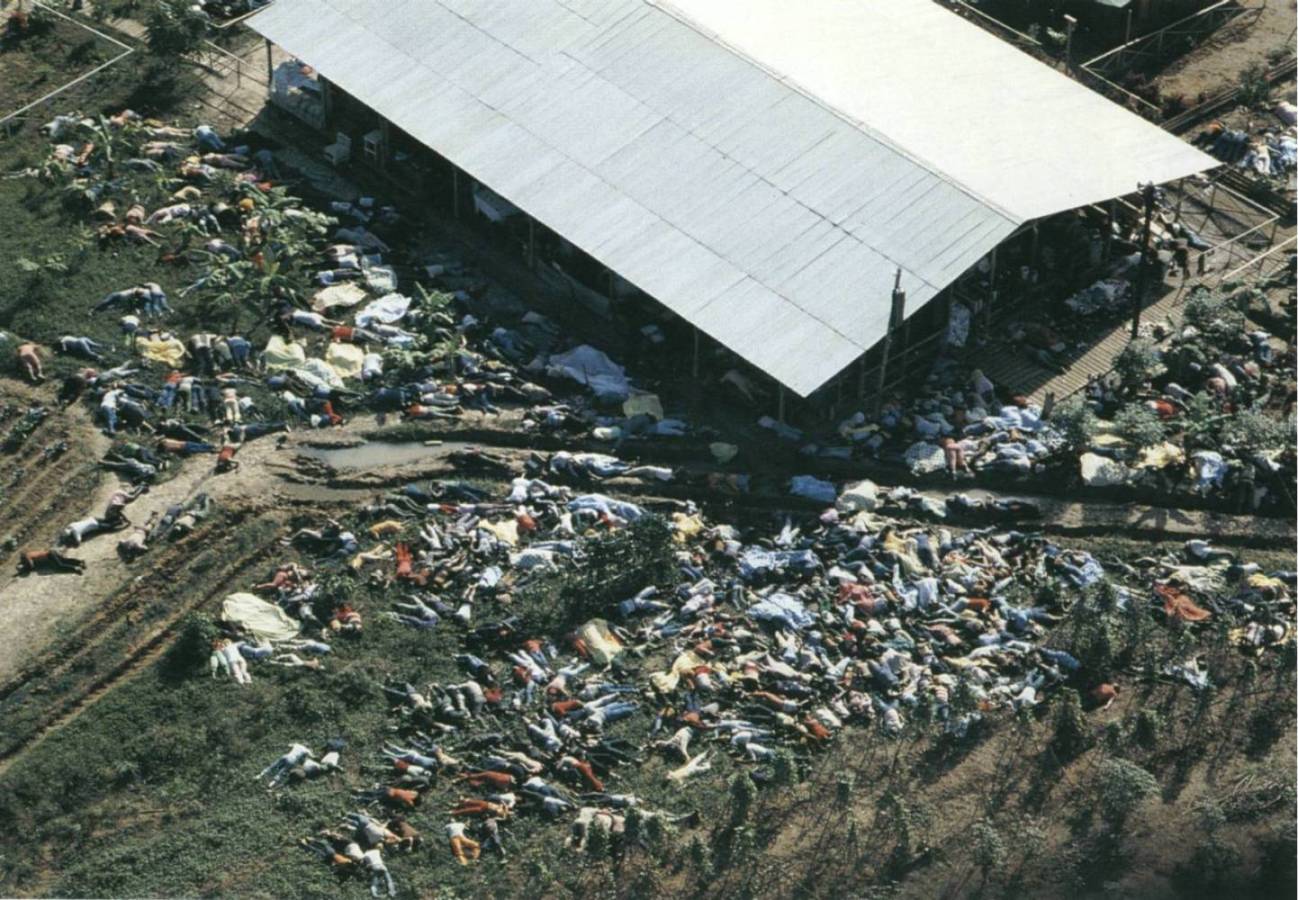Human Confetti in the Jungle of Guyana April 23, 2012
Author: Beach Combing | in : Contemporary , trackbackBeach prides himself in getting together some of the most striking photographs possible to show his students at uni. However, he is dismayed how often good photographs require dead bodies: a revolutionary Spanish soldier with his head disintegrating, Aldo Moro curled in a fœtus in the back of that fiat, Jesse James laid out, the living dead – the to-be victims of the Omagh bombing in the last minute of their lives, Maximilian’s execution shirt… And another picture from this dismal series might be this extraordinary shot taking from the air following the Jonestown Massacre, 17 November, 1978.
Jonestown was the single greatest sect killing in history. Jim Jones was a charismatic sociopath with maturing paranoid tendencies: the kind of man, in short, you pray not to sit next to on the bus. He had created, by his sixties, a religious community of almost a thousand American nationals in the badlands of Guyana. And he was convinced that the United States was attempting to undermine this community, based as the community was on a heady mix of Stalinism, Christianity and, what might be called, ‘Jonesism’.
In an attempt to protect himself and his community he began negotiations with the Soviet Union so as to seek a haven there: Beach can’t help reflecting that the Soviet Union, or Jones’ other preferred destination, North Korea, would have been more effective at dealing with Jim Jones than the federal government. But he also explored other options that he and his flock voted on including fleeing deep into the jungle and committing collective ‘revolutionary suicide’: a phrase that came from Huey Newton, a black panther whose cousin was, incidentally, one of the very few to survive Jones’ death orgy.
It is not clear how Jones justified revolutionary suicide to his flock. But he got them word perfect. Indeed, on one occasion he gave the thousand a red liquid drink, told them that they would die in the next forty five minutes and when they drank this he explained the ritual away as a test of loyalty.
By the autumn of 1978 with Jones’ health declining rapidly and the fury of relatives of sect members back in the States mounting it was maybe only a matter of time. When a visiting US congressman, Leo Ryan came to investigate a number of community members – perhaps a dozen, hardly the numbers that you would have expected – pushed forward to ask to leave. Ryan gained Jones’ permission. But Jones saw even this small defection as a betrayal and ordered that a vat of cyanide be prepared.
It is worth stating that when told to drink poison, the vast majority seemed to have done so without questioning the orders given. If this was murder, it was not the kind easily found in the penal code: that definition should be reserved for the visiting journalists and ‘defectors’ who were killed, with the senator, at the air strip. The result, in any case, were bodies spread through the floor of the jungle like so many bits of confetti. Jones ended his life (or did he ask someone else to do it for him?) with a revolver. An agent of Jones in nearby Georgetown killed two of her own children with a knife on hearing that Jones had spoken. Back in the jungle perhaps fifteen escaped death by various stratagems.
***
26/Apr/2012: KMH writes ‘Jim Jones had a similar charisma to Hitler who was often accused of being possessed. The same would apply to Jones even though his community was basically religious -communist. He and his followers were convinced that the Northern Hemisphere was destined for nuclear destruction, but life would go on more or less in the south. His followers drank the Kool-Aid (Flavor Aid) readily because they had drunk it ritualistically (for death) a number of times before with no cyanide, of course. This is where the phrase “don’t drink the Kool-Aid” originated. Kool- Aid and its imitators is made with sugar and mixed with a fruit flavour that came in an inexpensive packet of dry concentrate. In the fifties it was popular in the USA. Today we would call Jim Jones a classic example of a false prophet. The question is, did he have any real spiritual gift besides mesmerizing his audience with speaking ability. The evidence isn’t entirely conclusive. If so, he would fall into the line of Simon Magus of Acts 8:9-24 and qualify as a precursor to the false prophet of Revelation. Thanks KMH!



